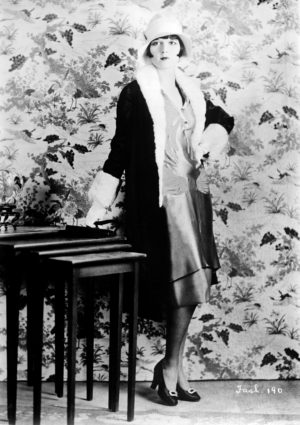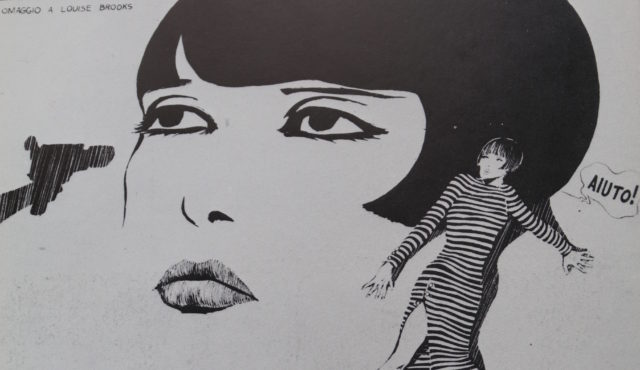An icon of the silent film era, Louise Brooks has a special place in the hearts of Italians thanks to a groundbreaking series of comic books and strips.
Black-and-white photos from the silent film era have an aura of mystery and nostalgia, and one of that era’s favorite subjects was actress Louise Brooks. Famed for her bob hairstyle and iconic flapper costumes, her influence has reached across the decades and far beyond American shores.
“Louise Brooks is my favorite actress,” Italian director Marco Tullio Giordana revealed when we spoke at the 2018 edition of Lincoln Center’s Open Roads: New Italian Cinema. “When I saw G. W. Pabst’s ‘Lulù’ and then Augusto Genina’s ‘Prix de Beauté’ (Miss Europe) with this extraordinary American actress, I fell madly in love with her because she was so representative of the actresses of her time and interpreted very strong and volatile female characters.”
 Austrian filmmaker Georg Wilhelm Pabst first introduced Europeans to Brooks with his infamous 1929 film, “Pandora’s Box.” Brooks portrayed Lulu, a name that she became synonymous with. Based on Frank Wedekind’s plays “Erdgeist” (1895) and “Die Büchse der Pandora” (1904), the film follows a seductive young woman whose sexuality and carefree ways break the hearts of those who love her and eventually cause her to self-destruct. Although the film was not a hit at first, it eventually caught on, helping to catapult Brooks to international stardom.
Austrian filmmaker Georg Wilhelm Pabst first introduced Europeans to Brooks with his infamous 1929 film, “Pandora’s Box.” Brooks portrayed Lulu, a name that she became synonymous with. Based on Frank Wedekind’s plays “Erdgeist” (1895) and “Die Büchse der Pandora” (1904), the film follows a seductive young woman whose sexuality and carefree ways break the hearts of those who love her and eventually cause her to self-destruct. Although the film was not a hit at first, it eventually caught on, helping to catapult Brooks to international stardom.
“Like many other American artists, Louise Brooks is differently and perhaps better appreciated in Europe. It was also in Europe, after decades in obscurity, that she was rediscovered,” explains Thomas Gladysz, author, founder and president of the Louise Brooks Society. “She made three films on the continent: “Pandora’s Box” and “Diary of a Lost Girl” for Pabst, and “Prix de Beauté,” a French film directed by the Italian Augusto Genina. It is because of these three films that Brooks is remembered.”
“Her haircut was so unique, it inspired a famous Italian comics designer, Guido Crepax, to use Brooks as model for his most famous creation, a character called Valentina,” says Tullio Giordana. It was Crepax’s character that immortalized Brooks in Italy.
Crepax launched the “Valentina” series of books and comic strips to reflect the psychedelic spirit of the 1960s, eventually penning 27 books between 1968 and 2003.
“These were longer form, not just throw-away comic strips or comic books,” Gladysz explains. “They were published in the United States in a magazine called Heavy Metal, which was sort of an alternative culture magazine. They’re a really big deal in Italy.”
Although Crepax was mainly responsible for burnishing Brooks’ image in more recent decades, according to Gladysz, other artists have been smitten with her and have drawn her into all types of comic books and graphic novels, keeping her very much in vogue in Europe to the present day.
“I would say that she is the actress who struck me most in the history of cinema,” Tullio Giordana proclaims. “Certainly, I am one who loves Katherine Hepburn, loves Marilyn, loves all the great actresses. But for me, she is something special.”
He vividly recalls a rare interview she did for Italian television in which she was “very radical and very clever, with strict judgments on the industry but also very human and very understanding.”
Brooks spent the last few decades of her life in Rochester, New York, moving there at the invitation of James Card, a film curator of the George Eastman House. She lived a quiet life and even watched some of her own films for the first time. She also reinvented herself as a writer, penning essays and articles for publication, many of which were collected in “Lulu in Hollywood.”
Much of Louise Brooks’ work is available on Amazon, including “Pandora’s Box” and “Diary of a Lost Girl.” Her collection of essays, “Lulu in Hollywood,” Thomas Gladysz’s books and Guido Crepax’s “Valentina and the Magic Lantern” are also available on Amazon. Visit the Louise Brooks Society at pandorasbox.com. Prints from Crepax’s “Valentina” series are available at scottedergallery.com.
The above appears in the October 2019 issue of the print version of Fra Noi. Our gorgeous, monthly magazine contains a veritable feast of news and views, profiles and features, entertainment and culture. To subscribe, click here.
 Fra Noi Embrace Your Inner Italian
Fra Noi Embrace Your Inner Italian






